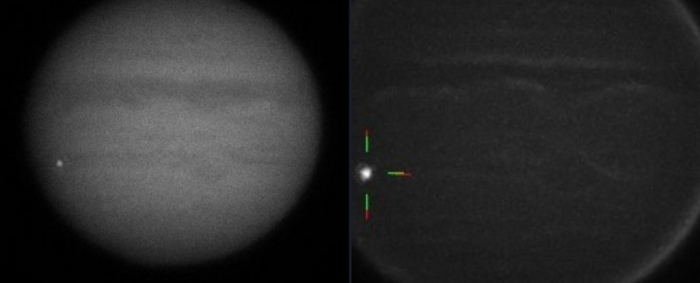On 7 August 2019, at 4:07 UTC, Ethan Chappel in Texas caught the incredibly rare sight on camera.
"Imaged Jupiter tonight," he wrote on Twitter. "Looks awfully like an impact flash in the [southern equatorial belt]."
"After I checked the video and saw the flash, my mind started racing! I urgently felt the need to share it with people who would find the results useful," Chappel told ScienceAlert.
Just watch. On the brown streak of cloud just below the equator, to the far left, a spot visibly brightens before fading - nothing like any of Jupiter's normal processes, such as lightning or aurora.
In fact, it resembled nothing so much as, well, an impact event.
"To get a video like that, I've never seen anything like that before," astronomer Jonti Horner from the University of Southern Queensland in Australia told ScienceAlert.
"That's just totally breathtaking."
A bolide impact on Jupiter isn't necessarily a rare event. Bolides - meteors that explode mid-air due to atmospheric entry - are pretty common on Earth, and we're a much smaller, much less gravitationally intense target than Jupiter.
In addition, Jupiter is surrounded by objects it can slurp in with its gravity: both short- and long-period comets, as well as asteroids from the belt between the gas giant and Mars.
In fact, a 1998 study found that the rate of large impacts on Jupiter was likely to be between 2,000 and 8,000 times the rate of impacts on Earth. But that doesn't mean we're likely to see them, and in fact very few have ever been caught on camera.
There was the comet Shoemaker-Levy 9 in 1994, which broke apart due to Jupiter's tidal forces, and produced a string of impacts. These were actually on the planet's far side, but the 2.2-metre telescope in Hawaii photographed the heat signatures of these impact sites as they orbited into view, and Hubble captured the dark smears left behind on the clouds, known as a scar.
Impacts were captured in 2009 and again in 2010. But for all their estimated frequency, actually seeing them happen is very rare.
"It's a very fleeting event, it's a few seconds," Horner told ScienceAlert.
"It wouldn't be so obvious, if you were looking through the eyepiece of the telescope. A lot of the time these things will go unnoticed and unobserved. Half of them will happen on the far side of the planet. So there's a lot of things working against seeing these events."
The fact that we have real-time video of the event, and can clearly see it brighten and fade, is the most exciting part, he said. It means we can compare the impact to other bolides, such as the 2013 Chelyabinsk meteor, to see how the length of time each event took to brighten and fade varies.
"I believe I was looking up at the sky for Perseid meteors when it happened, so I did not see the flash while recording," Chappel told ScienceAlert.
"I only noticed it afterwards thanks to a great piece of software called DeTeCtby Marc Delcroix, which is designed specifically for finding these flashes."
It's also possible the impact left a scar that can be studied by other instruments - Jupiter probe Juno, for example. Early reports suggest that the impact was too small to produce a scar, but we may get lucky.
We don't yet know how big the object was, but it would have to be relatively large in order to produce an event visible from Earth.
If you want to try your own luck with Jupiter photography, Chappel has kindly provided a list of his equipment on Twitter. He's also promising a cleaned-up image, so keep an eye on his Twitter feed.
What a fantastic achievement. We can't wait to see the science that comes out of it.
















































